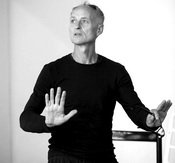Pál Frenák was born in Budapest in 1957. A defining aspect of his childhood was the fact that his parents were hearing impaired, meaning that he would first learn to express himself through sign language, which developed his sensitivity to facial expressions and gestures, the content that can be communicated through the human body. After his initial successes in Hungary, Frenák continued his career in Paris in the mid-1980s. There he collaborated with a number illustrious personalities from the world of classical ballet, and later founded the first of his own ensembles. His subsequent works were heavily influenced by the films of Italian director Pier Paolo Pasolini, the artworks of Francis Bacon, and the writings of French philosopher Gilles Deleuze. In 1998 he won the choreography prize from the Villa Kujoyama in Kyoto, which enabled him to spend more than six months in Japan. This experience also had a major impact on his art: Japanese eurythmy and visual art both appear in a number of his choreographies, as does the butoh form of dance. In 1999, he refashioned the Compagnie Pal Frenak, by then with ten years of history behind it, into a Franco- Hungarian ensemble expanded with young Hungarian dancers and based in both Paris and Budapest, which created a unique language of dance. The chief feature of this was the integrated use of mime, sign language, and body movement along with the incorporation of related genres (circus, theatre, fashion, architecture and contemporary music) into the creative works. With the dynamism of his own world of movement, the novelty of his unique sensitivity, and his forms of expression that transcend the verbal, Frenák brought a radical new style to Hungarian dance culture. His innovative use of bodies and space has had a decisive influence on the development of Hungarian contemporary dance. His works have twice won him the Rudolf Lábán Prize, and his most recent productions are nearly always nominated for this award honouring the best dance performance of the year. He was recognised with the Harangozó Award in 2002, the Knight's Cross of the Order of Merit of the Republic of Hungary in 2006, the Zoltán Imre Choreography Award in 2007 and the For Budapest Award in 2014, the Hungarian Artist of Merit in 2018 and Kossuth Prize in 2021.
